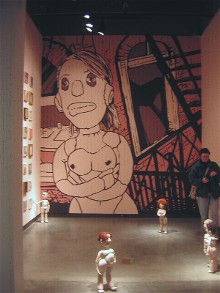
I-95 was about 5 m.p.h. faster than a parking lot and rain was sluiced over the windshield when Roberta and I drove to the Delaware Center for the Contemporary Arts. My previous visit there was also on a rainy day (image, installation detail of Adam Parker Smith’s “It Feels Good to be Faithful to You”).
But people sure seemed happy to see us when we finally got to the front desk.
Drifting through the galleries, we slowed down for Adam Parker Smith’s stuffed dolls. Smith, who has a show coming up at the Painted Bride soon, is now making sweet little sewn nude figures–Cabbage Patch dolls with pubic hair, breasts and penises. The hair above and below is made of yarn. One of the men looks like he’s got hairplugs embedded in his scalp. The men and the women look like they like one another. That’s refreshing. The installation suggests a docent giving a talk to a bunch of art lovers admiring portraits of themselves.
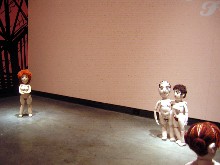
The gallery also has a giant mural and a grid of small portraits of the dolls–made by Smith and his friends of paint, photos, collage, etc. Some are even embroidered. These stitched ones were among my favorites (image, Smith’s dolls, standing).
We’ve seen Smith’s work before, notably work influenced by picture postcards and True Romance style magazine covers and comics–at a CFEVA show in May (post) and at Sean Stoops’ great apartment show, the Home Show (post), in February. But at DCCA, the bite and anger that put the lie to romance and love in those 2-D works is gone, and the sculpture is all about puppy-boy-in-love, and friends-4-ever. The strength lies firstly in the ordinariness of the clunky little figures and the ordinariness of their exposed sexual traits, and secondly in their activity, taking a tour of the museum where they are both viewer and viewee, several times over.
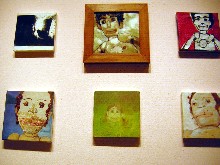
While we were looking, a couple of women came in with the sales list, checking which of the paintings were still available. We asked if they were collectors. Yes, plus one was an artist, too. They behaved just like window shoppers, picking out this one and then switching to that one, deciding how many to take, and just bubbling over. This, too, was refreshing (image, detail from the grid of doll portraits).

Later, we stopped at the “Time Spent” exhibit of Gretchen Hupfel (image, Hupfel’s “Interference 1 (also known as All in One Garage),” photo with digital image output on vellum, 36 x 107.5 inches).
In came one of the collectors who had been shopping the Smith paintings. She was the non-artist, and she mentioned that Hupfel was her daughter. Roberta expressed her sorrow at Gretchen Hupfel’s untimely death. Then we stayed for a while pondering the various ways that Hupfel made art.
Hupfel’s computer generated work adds directional markings and planar grids on photographs, book pages, even keypunch cards. The added-on dimensions and points of view suggest a world richer than what our eyes normally behold.
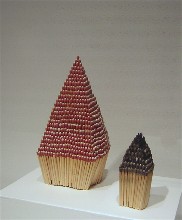
But Hupfel also created work that was outsider obsessive, rolling up layers of cellophane tape or gluing together matches to create reductive, elegant shapes (image, “Time Spent,” matches and glue).
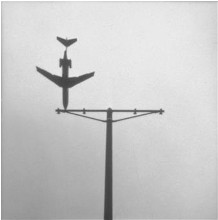
The work also included sand-blasted glass, assemblage, video, painting–a surprising range of interesting, conceptual work (image, “Horizontal Stabilizer,” 2 x 2 inches).
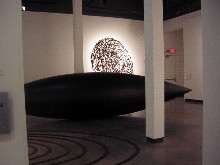
We also stopped in to see Ron Klein’s “Inside Out,” which takes the seed pods of his show at Pentimenti and pushes it farther, adding mechanical objects like springs and coating things in colored wax. The giant blank inflated dirigible shape in the center of the gallery anchors it all (image, installation detail of “Inside Out”).
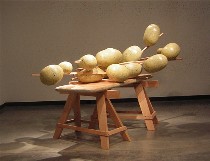
Nearby we visited Christopher Romer’s wood sculpture, beautifully crafted with milk-paint coatings crying out for our touch. We also passed by Leonard Ragouzeos’s india ink giant, hairy heads. We saw well-done realism and craftsmanship here (image, Romer’s “An Old Fashioned Work Horse”).

We found some poetry when we stopped in the group show Parallel Visions, thanks to Carla Lombardi’s clay “Pom Pom Girl” and her three “Fashion Plates.” The latter are irregular, heavily glazed plates that hark to red-figure Greek pottery. The plates are embellished with women in and out of fashion attire. Way more ambitious in scale, the pom pom girl was a Greek Pan or Roman faun, a free spirit operating outside the rules of decorum. Lombardi’s pieces were a juicy, nice surprise (image, Lombardi’s “Pom Pom Girl”).









